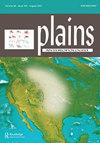Don’t fence them in: comment on “perishable artifacts from Last Canyon Cave, Montana”
Q2 Social Sciences
引用次数: 0
Abstract
Through a framework of ecological zones, rather than state boundaries, the cordage and juniper bark item from Last Canyon Cave provide an example of the long-standing pattern of Great Basin cultural developments extending into the adjacent mountainous areas. Kornfeld and others (2021) present a significant find: a possible plaited mat or sandal fragment from Last Canyon Cave in southern Montana. While new reports of perishable artifacts are always of interest to Plains Anthropologist readers, the article is predicated on fuzzy geographic and temporal concepts. To begin, Ludlow Cave is not in Wyoming or Montana (Kornfeld et al. 2021:384); it is in northwestern South Dakota. While seemingly trivial, this mistake raises larger concerns about imposing the political boundaries of settler-colonists onto Native American cultural territories. In short, Wyoming is not the “High Plains,” and Wyoming and Montana are not equivalent to the “Northwestern Plains.” Should western Wyoming and the adjacent portion of Montana where Last Canyon Cave lies, be included in a “Northwestern Plains” region? Although many archaeologists have persisted in this practice, physical geographers and ecologists place western Wyoming and the Last Canyon Cave area not in the Great Plains province but in the North American Deserts region, more commonly called the Great Basin (Commission for Environmental Cooperation 2006). While it would be simplistic to define cultural areas solely on environmental zones, it seems even more facile to imagine that Native American culture areas coincide with the modern political boundaries of settler-colonist entities, such as US states and Canadian provinces. “Wyoming and Montana” are not coterminous with the Northwestern Plains ecoregion, but include portions of the Northwestern Plains, North American Deserts, andMiddle Rockies zones. Conversely, the Northwestern Plains ecoregion includes most of North and South Dakota, the eastern plains anthropologist, Vol. 67 No. 262, May 2022, 194–196不要把它们围起来:评论“蒙大拿州最后峡谷洞穴的易腐文物”
Last Canyon Cave的绳索和杜松子皮制品通过生态区而非州边界的框架,为大盆地文化发展延伸到邻近山区的长期模式提供了一个例子。Kornfeld和其他人(2021)提出了一个重要的发现:一个可能来自蒙大拿州南部最后峡谷洞穴的编织垫子或凉鞋碎片。虽然平原人类学的读者总是对易腐文物的新报道感兴趣,但这篇文章是基于模糊的地理和时间概念。首先,勒德洛洞穴不在怀俄明州或蒙大拿州(Kornfeld等人,2021:384);它位于南达科他州西北部。虽然这一错误看似微不足道,但它引发了人们对将定居者殖民者的政治边界强加给美洲原住民文化领地的更大担忧。简言之,怀俄明州不是“高平原”,怀俄州和蒙大拿州也不等同于“西北平原”。怀俄明州西部和最后峡谷洞穴所在的蒙大拿州邻近地区是否应该被纳入“西北平原地区”?尽管许多考古学家坚持这种做法,但物理地理学家和生态学家将怀俄明州西部和最后一个峡谷洞穴地区不是在大平原省,而是在北美沙漠地区,通常被称为大盆地(环境合作委员会,2006年)。虽然仅仅根据环境区来定义文化区是简单的,但想象美国原住民文化区与美国各州和加拿大各省等定居者殖民主义实体的现代政治边界重合似乎更容易。“怀俄明州和蒙大拿州”与西北平原生态区并不相邻,但包括西北平原、北美沙漠和中落基山脉的部分地区。相反,西北平原生态区包括北达科他州和南达科他州的大部分地区,东部平原人类学家,第67卷第262期,2022年5月,194-196
本文章由计算机程序翻译,如有差异,请以英文原文为准。
求助全文
约1分钟内获得全文
求助全文

 求助内容:
求助内容: 应助结果提醒方式:
应助结果提醒方式:


